A pile of conference badges. If you look closely, you'll see Maddog's badge on top.
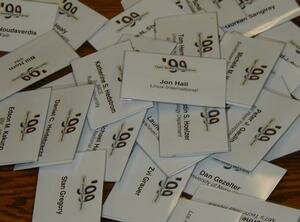 |
It was sometime during the week of Oct 4th. The day was sunny, bright, the sky a piercing light blue. I was walking north along Bell Avenue in Brookhaven National Laboratory on my way to the bank. I had just finished lunch and was savoring the walk. It was quiet, peaceful. The first sunny, crisp days of fall had arrived. The peacefulness surrounding me was so impressive. It had been 4 months since I've been able to enjoy such a quiet moment.
"What do you mean there are a busload of people wandering lost around the RHIC ring!" I replied to one of the organizers after being interrupted from fidgeting with that damn PC projector. "That's what I've been told, and YOU HAVE TO DO SOMETHING!" she replied. I ran out to the lobby in a frantic disposition. One of my PHENIX collaborators was walking around looking at the vendor exhibits. "Please John, go out and find those wandering conference attendees and give them a tour of the PHENIX detector!" He looked a bit puzzled as I explained the situation to him, but was off in a rush after he understood what was going on.
That's me making cables. One of those valuable Ph.D. analytical skills I've picked up. The poster/demo room's IT infrastructure needed to be assembled and thus there you have me making RJ45 cables.
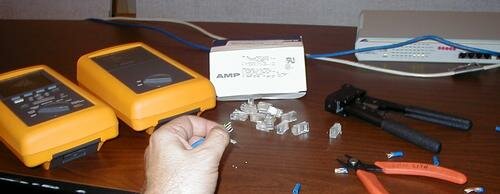 |
That was October 2nd, the day of the Open Source/Open Science conference. The whole day was a series of crises. The first crisis started that morning when we fired up the projector which was hooked up to the PC running Linux. The projected image jittered in such a way as to give me a rather nasty headache. "This will not do!" I exclaimed. Malcolm, one of the organizers swore again and again that it was working great the night before. "Hooking up a another laptop or PC is no easy feat" he warned me. It takes a good 20 minutes to figure out the settings on the projector so that it will sync properly with the video output. What to do - what to do. I had 15 minutes before the conference started, and the only working PC/projector setup was running Windows NT. What an embarrassment for an Open Source/Open Science conference. I was not going to do my introductory talk with the NT desktop brightly displayed behind me, as I used IE to down load my presentation. I had my laptop setup on a table on the auditorium stage from where I was going to run the conference. My intent was to monitor the inbox of the osos account on that laptop, to which people were to send their e-mail with questions I was to ask the speakers. I took down my laptop, set it up next to the projector, plugged in the video cable and pressed fn-crt which in theory should enable the video output on my laptop. Nothing. A big blue box shown on the screen with a clear message reading "No video sync." The conference was to start in 10 minutes. I quickly booted my laptop into windows 98, and back into Linux. The video projector came alive and projected my GNOME desktop after logging into my account. 5 minutes to go and I had a working Linux desktop environment projected onto the screen for the audience to see and from which I would present the introductory talk. Wheeewww. Crisis #48 averted....
A view of the RHIC tunnel with some of the invited OSOS'99 guests and then some. Of those who I recognize are Gabor David of PHENIX on the far left, John Hall 5th from left, Mark Galassi one over from John Hall, followed by Fred Johnson of DOE, skip one and then Michael Johnson of Red Hat and finally Bruce Perens.
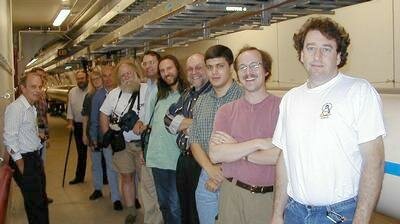 |
The idea for this conference was begot back in early June after a lunch I had with Sean McCorkle. As we walked out of the cafeteria, Sean suggested that we put on an Open Source conference. This was the same idea I had in the back of my head for a long time now. "I would be glad to dedicate time for an Open Source conference," Sean told me. He said it with a zealot's enthusiasm whence I knew he meant what he said. With that bit of encouragement, I told him that we should "explore" the idea further.
A couple of days later, Malcolm Capel, a big Linux user doing structural biology work at the Light Source, Tim Sailer, a big Linux (Debian) developer, who was working for the RHIC computing facility at the time, Sean McCorkle, who does database work for the Human Genome project and myself, who spends much too much time on these silly write-ups, gathered during lunch to push forward this idea of organizing an Open Source conference at the Lab.
Same gang, but now we are posing for a photo op in front of the STAR detector. This is one of the two BIG detectors ready to study the creation of the Universe at BNL. Maddog took this picture.
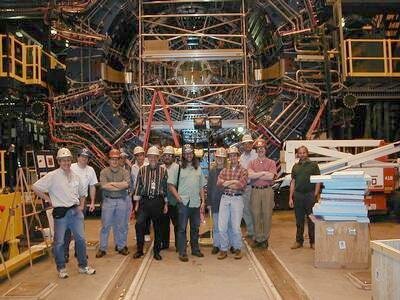 |
"Let's get Maddog." "How about Bob Young." "Yea, IBM just released its data visualization software under an Open Source copyright license. Let's get them." "SGI has a bunch of Open Source projects, XFS etc." "Hey, Lincoln Stein wrote the CGI perl module. He works at Cold Spring Harbor Lab, that's right here on Long Island. He'd be a great speaker!" And so the meeting went. By the time lunch was over I asked the question, "So will it be worth having an Open Source conference?" The consensus was yes, its worth the time and effort. I can't remember who, but someone said that working on a conference takes up all your time. This was in reference to a conference which was recently held at BNL where 300 people came for a week to talk about small angle scattering experiments at the Light Source. The head organizer spent all his time working on the conference. We blew that fact off. "It's only a one day conference." (That phrase would be uttered many times between then and Oct. 2nd.) "How much time could it possibly take?!" It was going to be a bunch of guys from BNL plus a couple of outside speakers. "What's the big deal!"
I couldn't resist this photo. The PHENIX central magent system is in the background, with its logo painted on top, and Bruce Perens Penguin Power t-shirt logo in the forground. Nice juxtaposition of symbols.
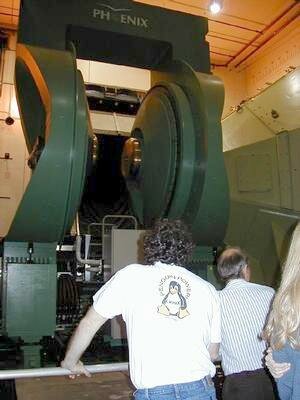 |
This brainstorming session stirred my blood for some action. I fired off an e-mail to Bob Young, Maddog, and Richard Stallman. I had met each one of them from previous meetings I strayed to earlier this year. The e-mail outlined the idea for the conference and asked for feedback. "Is this a good idea or not?" Bob replied within several hours. He thought it was a good idea. Maddog got back a couple of days later. He also thought it was a good idea. I didn't hear back from Richard for a couple of months. (Some e-mail glitch was at fault and the outcome turns out to be a whole 'nother chapter.)
With that positive feedback from Bob and Maddog, I asked to meet with Mike Murtagh, the chair of the physics department. "It's a software conference." I told him. "We spend too much of our time on software not to talk about it." I told him about IBM and SGI and their software work and about how our software affects our science work and how people may be interested in what we do, etc. Mike was warming up to the idea and it wasn't until about 45 minutes into this discussion that I spoke the words "Open Source" and "Free Software." When I did, Mike uttered a long "Ooohhh, that's what this is all about" with his signature Irish accent. He had visions of people dressed in tie-dyed tee shirts, purple colored rim sun glasses, and flower sack dresses forming a "Free Software" commune on site during the conference. "That's not quite the idea Mike, but it's close..." Mike told me that he noticed that I didn't say "Open Source" or "Free Software" until well into the discussion. I did that on purpose.
Getting other Lab officials involved in the conference was something I didn't like. "They're going to hijack the idea and run away with it and take all the credit for it!" I told Mike. Mike was sensitive to this problem, but left me no choice. Either the Lab management was to get involved and give their stamp of approval or there was going to be no conference. "You can always reserve a conference room and invite your speakers, but if you want the Lab's logo (and resources and money) to back your conference, you have no choice but to get one of the departments to back you." Mike continued, "If it were a Physics conference or workshop, I could see the physics department backing you up, but for this one, you need to go to ITD." (ITD is the Information Technology Division.) I don't know why I was so jealous of this conference idea. Who on earth would want to take over this Open Source conference? No one in the Lab management had ever heard of the term "Open Source" and they had no interest in the matter. (As it turned out, this was mostly true. There were several "directors" in the directors office (we have lots of directors) who, in the end, did show interest.) I guess what I was worried about was that my efforts in trying to promote this as a computing conference as much as an Open Source conference would get those with computing empires at the Lab to take note and take the conference over. Hindsight has proven that this was the least of my worries.
Berkner Hall, the building where the conference took place, at about 7am the morning of the conference. That was the last quiet moment I had before my crisis management skills were tested.
 |
Nice photo of Maddog starting his talk.
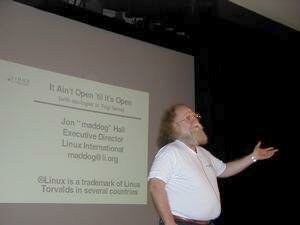 |
From that meeting, Mike told me how to proceed. Make sure I get ITD management to back the conference. I had to broach the idea to them which meant getting ITD involved. We also needed to get someone from the Directors Office involved as well. My tendency was to go straight to the top, but Mike warned me that the first thing anyone in the directors office would do is consult with Don Fleming, the new Lab CIO and chair of ITD.
While I was pushing the idea of this conference through my contacts, Sean and Malcolm were pursuing the idea of the conference through Biology. From that we got two key people on the organizing committee. Donna Zadow and Ann Emrick. They are pros in this conference stuff, which I would later find out. "Let us worry about getting the speakers here, you worry about the content of the conference." That was a phrase they kept telling me. (And they were right.)
A picture of the LUG tables. The Conneticut Free Unix Group's table is in the forground and the Long Island LUG is in the back. Larry Augustin is hanging with the LILUG guys trading Linux war storries. CFUG is working on getting X to run on the FreeBSD setup. Give these guys a power strip and an RJ45 jack into the Internet and they're set to go.
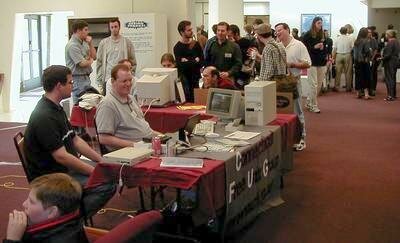 |
After several weeks of having meetings to meet with X, Y and Z, meeting with X, Y and Z and then having more meetings to meet with U, V and W, we finally got 3 of the working folk of ITD involved. Tom Schlagel, Ed McFadden and Susan McKeon. Ed really pushed the conference idea. He wanted to set up meetings with Don Fleming and Jim Glim, the new head of the Center for Data Intensive Computing. We needed to get their OK for this conference to proceed. And at about this time, word started to leak to them of the conference as well as to Peter Paul, the big cheese in the Directors office. As I said, we have many directors. At the top is the Lab director, Dr. John Marburger. He had no interest in any of this, which was leaked to me by his secretary when she called about a month later, to inform me that he turned down my personal invitation to attend the conference and VIP dinner. Under him there is Peter Paul, who is the scientific lab co-sub director. There is another guy who is also a co-sub director who is in charge of the non-scientific aspect of lab management. The guy to talk to was Peter Paul. If we got his OK, then we knew the conference would happen. But we wanted to make sure he heard it from us, the original organizers. Not the head of ITD or anyone else. We had the idea first, and we want to make sure Peter knew that. (Again, I don't know why I was so jealous of this fact, but I was.) So, Malcolm, Sean, Tim and I decided on a pre-emtive strike. Instead of letting Peter hear about the conference from Don Fleming, or anyone in ITD, we were going to go to him first. The guys from ITD said that having this meeting with Peter Paul without someone from ITD would make it look disorganized and could potentially derail the conference. We didn't care, "This is just a pre-meeting" to tell Peter what was coming down the pipe. "It's just a heads up thing."
The SGI table. Chris Porter is on the left and Ken Howard of Comnet, a local SGI reseller, is on the right. They're showing off their L1400 server.
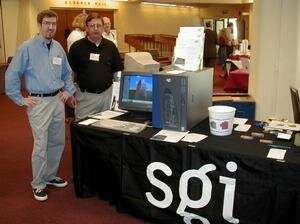 |
So I called Peter Paul's secretary, set up a meeting and within a day we were talking to him in his office. "We want to have the accelerator facility, the Light Source and the lab scientific infrastructure as a backdrop to this conference." "It's a great way to promote the computing efforts of the Lab." "Look, people use this same software on their PC's at home that we use to do our research. This commonality is a great way to get them into the lab and show them around." And so we pitch the idea. "Wait a minute!" he said, shuffling over to his Xterminal, groping for his mouse. Click, click, click. "Hmmm, October 2nd? I won't be here." Pause.... "But I don't have to be here for the conference do I..." Finally after about 30 minutes of pitching the idea to him, (some small/short heads up meeting this was, it was a full blown presentation,) he asked, "Well, what do you want from me?" It suddenly dawned on me what he was really asking, was "How much money do you want from me?" After a brief pause to think about what he was really asking for, I said. "We need money." I didn't say anything about how much we needed. He just offered to kick in $2K to get the conference going. He's got his own directors stash which he can do with as he pleases and that afternoon he gave us, what turned out to be, the last $2K he had in his scientific co-directors fund. Looking back on this, that was quite a feat on our part. Peter just donated $2K to help promote the use of "Open Source" software at BNL. More importantly, we got the official backing from the Lab Mike Murtagh told me I should get. But there was still work to be done. Peter said that we got his blessing and money but we still needed to get ITD to fully back the conference. This meant we needed to get back with the ITD contingent of our organizing committee and schedule a meeting with Don Fleming.
The AndoverNet reps read my Slashdot paper and wouldn't let me leave without getting a picture taken with me. I tried to explain to them that my /. paper was a bit of joke, but that didn't phase them. They still wanted a picture with "Dr. Adler". What could I do?
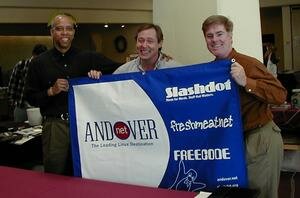 |
In the meantime, I set out to try and get other departments to contribute money to the conference. Our eventual plan was to hit up the vendors for money by selling ad space on our conference web site and floor space in the auditorium lobby. But for now, we needed some "startup" funds. Physics and the Light Source kicked in $2K each without much fuss. Mike knew that I would need money. I asked if I could put money in from my own computing funds for the physics department. He OK'ed that. I sent an e-mail to the head of the Light Source and that was all it took to get $2K out of him. Chemistry never responded and I was told that Biology had no money. (But we did get 4 people from Biology on the organizing committee, a much more valuable contribution. And we did eventually get $2K from Biology, thanks to Ann Emrick, about a month later which was a real help.) Mike Murtagh told me that I could ask one of the physics secretaries to help with the conference and I was able to recruit Bonnie Sherwood, another gold nugget. The other missing component of this conference was a budget. Ann Emrick worked up a MS Excel spread sheet with a bunch of costs she could think of. "You need XXX for lunch, the conference banners will be that much, the buses will cost this much." She had the figures pretty much on the ball. The total cost of the conference, if we did get 450 people to attend, would be $25K. The biggest single and unpredictable cost was the food which was going to be $25 per person. If we added a $25 entrance fee, the cost would be $15K. We got $6K in the bag and needed $9K more to go.
A shot of the panel disussing how we can get DOE and BNL to GPL the software they write, among other issues. From left to right are Maddog, Larry Augustin, Oggy Shentov, Mike Johnson, Bruce Perens, and Fred Johnson.
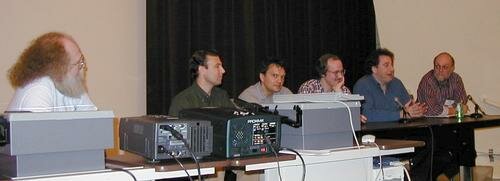 |
This set the stage for the crucial meeting with Don Fleming. We knew the numbers, we had a rough idea of who we were going to invite, the date of the conference and all we really needed now was someone to sign the lab conference paper work. In order to have a conference at the Lab, you are required to fill out a form, get a head of a department to sign it and submit it to staff services who works within the director's office. This will then get an account created where one can deposit money and more importantly, spend it.
Mark Galassi on the left, Constantine Olchanki with is back to us and Sean McCorkle on the right are blowing off some steam after the conference finished. We are siting around waiting for rides to the Bellport where we had our VIP dinner.
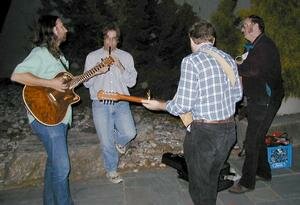 |
The meeting we had with Don Fleming was a small one. Tom Schlagel was there, along with Ed McFadden, Sean McCorkle and myself. We pitched the idea to Don. Don got into the Open Source bit. Microsoft vs the "Free Software" community was a theme he picked up on. He saw this as a way of promoting ITD and the new computing initiatives the Lab was embarking on. After about 30 minutes or so he wanted to know "What do you want from me." Again, that question popped up which really meant, "How much money do you want from me." We pull out the spread sheet, showed him the figures. "We have $6K from other departments, the conference will cost $15K" I started. I then I told him we would try and raise as much money from outside sources as possible, implying that this would repay any money he gave us. "OK he said, I'll cover the remainder." Meaning that he would give us up to $9K for the conference and he would sign that form needed by Staff Services.
Bingo! That was it! We had our conference! There was no turning back now!
*commit* *commit* *commit* *awwuuuugah* *commit* *commit* *commit*
Its a shootin war now, boys.
Was one e-mail Sean McCorkle fired off to our internal organizers e-mail list. Just after that meeting, I had to give a talk to the PHENIX detector council. The head of the online controls group, the group I worked in for the PHENIX experiment, touted this talk as some kind of opportunity to get in front of the senior scientist of the experiment and "get some exposure." I was on such a high going into that talk, that they must of thought I had lost it. I was so giddy during that presentation. There is always some kind of tension in the PHENIX experiment coming from a competitive attitude within the various subgroups. This manifests itself through criticism of ones work as being insufficient, late, not working or whatever angle of attack your colleague conjures up at the moment. The speaker before me was one such notorious colleague who would be quick to "qualify" any statements I said about my particular project for the PHENIX detector. As it turned out, I wouldn't care less what anyone in that room thought about what I was presenting. And I was talking away, at a mile a minute, bouncing around the front of the room, making jokes about the work, heading off "suggestions" from my notorious colleague with out a pause, and all the time I had one thought screaming in the back of my mind. I had just raised $15K to put on an Open Source conference at the Lab. "PHENIX detector council, eat your heart out!" Of course I never said that to them, but they must have known something was going on.
Malcolm Capel setting up and testing the display projectors used for the conference.
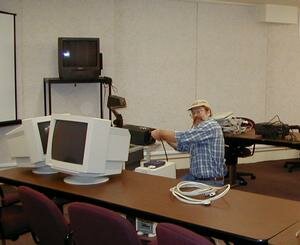 |
The next step was to try and raise money from the Linux business community. I got a copy of the Linux Journal and made a list of every company who advertised there. I then split up the companies into 3 groups of which I was in charge of calling up 1/3 of them. The other 2/3rd's were delegated out to two others in the organizing committee. Sean McCorkle snagged someone from Microway. He asked me to follow through with them. I spent a couple of days working down my list. I learned a valuable lesson during this part of the fund raising campaign. One of the hardest things to do is call someone up you don't know and try and sell them on the idea of giving you money. It is a humiliating experience with a capital H. I have gotten a gazillion calls from vendors trying to sell me their products and I usually keep their pitch short and send them on their way. Now it was my turn to be on the other end of the phone. Most of the time I couldn't get through to the person in charge of promotions. A lot of the times all I could do was send e-mail to these people and never get a reply. But there was the occasional time I did get through to somebody. The first one I did get through was KAI. I managed to pitch the conference to someone important there. A week later, I got an e-mail that they were interested in the coffee break sponsorship. Another victory celebration erupted immediately.
Bonnie Sherwood and Elaine Dimasi pictured the day before the conference as they sorted out the badges for the registrants.
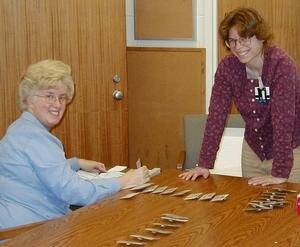 |
Through out all this, we kept brining up the idea of getting a "major sponsor" for the conference. They would contribute the full amount needed to organize the conference and this would free up our time to organize it rather than wasting precious time on this fund raising task. "Ask Red Hat, they got lots of money." Was one comment. "These guys are flush in Venture Capital funds." Referring to the general Open Source business community like VA Linux and others. So it was left to me to try and contact Red Hat and VA Linux. I knew Jim Gleason of VA Linux from the NYLUG so I contacted him. He gave me names, numbers and e-mail address of those over in corporate HQ who could make the decisions. I contacted (via e-mail) Bob Young and pitched the idea. He warmed up to it. VA Linux after a couple of days told me that they could only be a minor sponsor. "All our funds have been committed for the year" I was told. Fair enough, we were pushing to fund a conference about 3 months before it was to take place. (Its now mid July.) Also, everyone in Linux land was getting ready for the Linux World Expo in San Jose CA (early August) and I knew that OSOS would have to take a back seat to that event until it was over.
Parallel to raising money for the conference, we started to worry about promoting it. When we first started working on organizing it, I thought that a couple of postings on Slash Dot, Linux Today, Linux Weekly News, Freshmeat and some well chosen news groups would be all that we needed. WRONG! The first thing we needed to do was get the word out to those who worked at the lab. "Simple!" I thought. BNL has a Public Affairs office (PA) who's sole purpose is to promote the Laboratory. I would just use those resources.
Lars Ewell on the left, who's my office mate, and Martin Purschke, who does online work for the PHENIX experiment are pretending to show off a poster which is going to be presented at the conference. The poster was made by Martin.
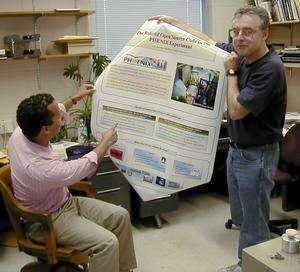 |
"You can't use the term Open Source. Nobody know what it is." I was told by PA, in response to our text for the BNL e-mail announcement I wanted them to send out lab wide. "What do you mean I can't use the term Open Source. It's an Open Source conference. It's in the Title!" I argued. "Also, no one knows what source code is. You can't use that term either" they continued. "We asked someone here what they thought source code was and they said it must be some kind of government specification for plumbing. Sorry, you can't use it" PA said. I couldn't believe what I was up against. PA continued, "Also, we don't e-mail lab wide announcement of conferences. No body is interested in conferences, and that is not our job. We do have a special e-mail list which people sign up to where we can post your announcement too. It has about 800 people signed up" they boasted. I checked out who was on the list and it was slim pick'ns as far as laboratory scientists and engineers went. I had never heard of this announcement e-mail list which PA was telling me about so how would the rest of the lab know about it. And I have been at the lab for over 10 years!. So be it, we did our best to reword the text for our e-mail announcement to the Lab, replacing the terms Open Source and source code and let them send out the e-mail to the their 800 list subscribers. This generated about 30 hits on our web site of which about 5 were interested in the conference. We had to do something. We used the lab channels and came up empty handed. Furthermore, of all the people I asked, no one had gotten our e-mail announcement. And I asked all my colleagues who I worked with who I knew would be interested in it. This left us with little recourse but to SPAM the Lab. We were left with no choice. We were going to get the word out to the Lab via e-mail no matter how high the obstacles PA and Lab management were going to throw up in our path. So, after about 2 hours of perl scripting, I was able to generate a list of over 5000 e-mail addresses of anyone who in one way or other was involved with the Laboratory. After setting the mailing in motion, (I had to send out the e-mails slowly since there was the possibility of crashing the NT mail exchange server of the Lab and if the OSOS SPAMing did so, we would be in big trouble. It had happened once before with a situation not related to our conference and thus our caution) we got a healthy hit rate on our web site and everyone I talked to had received notice of the event. Sorry Public Affairs, but we just had to do it. You left us no choice in the matter.
The photo of Eliane Dimasi, Bruce Perens and Jon "maddog" Hall during the pre-registration dinner.
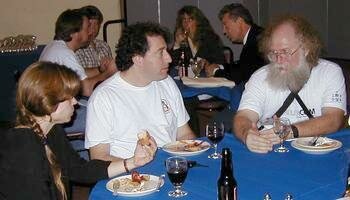 |
But that was just the beginning of our efforts to get the the word out. We spent a healthy 2 weeks generating our own mailing list of colleges and Universities through out the NE to which we would snail-mail a flier announcing the conference. But we realized that we needed to do more. We further realized that we didn't budget a penny to advertise the conference. By this time, I was able to get KAI, SGI, Portland Group and others to sponsor the conference. We had generated about 5K in sponsorships at this point. So we decided to spend all those funds on advertising. Also, this was just around the Linux World conference. It turned out that Donnie Barns was talking with VA Linux during Linux Expo, about a possible joint major sponsorship. A week later I got e-mails from VA Linux and Red Hat that they were interested. This sent chills down my spine. This was the mother load! The organizing committee huddled and tried to figure out how we would "package" a major sponsorship. It was rather easy. We would put their names and logos on every bit of real estate we owned, on the web, on every banner, conference bag and brochure we would print. Anywhere and everywhere we could think of, Red Hat's and VA Linux's logo would be there. They like it, and we got $25K. Thank God, because we spent it all on advertising.
Bill Horn talking about openDX.
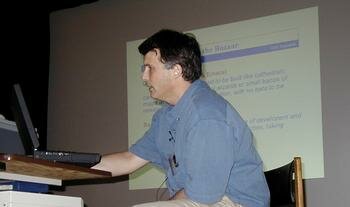 |
The NY Times science section and Newsday took up the lion's share of advertising funds. We also got 10 days of prime time space on WSHU, the local public radio station broadcasting out of Connecticut. My guess is that we got word out about the conference to well over 100,000 people. In the end over 200 people showed up, a 10^-3 effect which is what I expected. The important thing was not so much that we got over 200 people to attend the conference, but that hundreds of thousands of people saw the Brookhaven Laboratory logo associated with Open Source software along with Red Hat and VA Linux. In a country of 250 million people, hundreds of thousands are not large numbers, but you have to start somewhere. And the long term effects of this "brand name" association are yet to be known but I'm sure it will be positive. (Dr. John Marburger, the director of the Laboratory, should be very grateful of us for what we did here.)
"Where are those PC's!"
Jim Gleason and Ari of VA Linux screwing around for a photo op in the basement of the Physics building while we were looking for Xterminals.
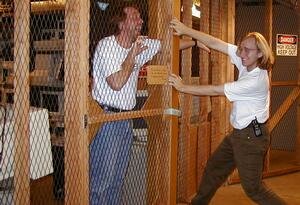 |
By the time the spots on NPR started airing and the ads in the NY Times and Newsday started to appear, the registration rate started to pick up. It peaked the weekend before the conference. All that was left was to make sure we put on a good show for the attendees. (Ehmm, I meant to say a good "conference".)
"What do you mean the VA Linux PC's are stuck in NYC?" I asked Jim Gleason. Those were the PC's we were going to use for the Post/Demo room. "Its a union thing" he replied. "The Fed Ex guy wasn't allowed to cross the corridor to pickup the boxes. Only a union guy could do that." Where are are we going to get replacements? "Sean, Ed, Heeeelp!" (Sean McCorkle, Ed McFadden and I managed to scrounge up enough Xterminals from around the Lab to cover the missing VA Linux boxes.) "What to do you mean we have to have to conference photo in the back of Berkner. I want it taken just out side the main entrance!" I told Ann Emrick. "Sorry, the photographer said there was too much sun light" she replied. Who ever heard of too much sun light!
The VIP Dinner. From left to right are Steve Adler (me), Larry Augustin; CEO and co-founder of VA Linux, an attendee, Sean McCorkle, Ari of VA Linux, Ed McFadden, Maddog and Bruce Perens. My stiff drink is hidden behind that carafe.
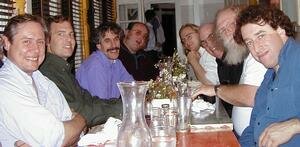
|
And so October 1st and 2nd went, one crisis situation after another. The day flew by and before I knew it, what remained of the speakers and who ever I could find hanging around after the conference, were seated at The Bellport, for our "VIP" dinner. It was all over at that point. I had a stiff drink which I rarely do. "A whiskey on the rocks please, and make it a double." Everyone seemed to have a good time there. I spent most of my time reminiscing about DEC hardware with Maddog, Larry Augustin, and Bruce Perens.
The following week I started to hear feedback on the conference. As best as I can tell, it turned out to be a great success. The most admirable compliment came from Tom Kirk, the associate director for Nuclear and High Energy Physics. (He makes all the decisions regarding future nuclear and high energy experiments at the Lab. In other words, he's an important guy.) He told me that the conference, when looked back several years from now, would be considered as a key turning point on the topic of Open Source and science. I also got word that a lot of good things were said about the conference through out the directors office.
There I am on the left with Sean McCorkle on the right. Cheers to the Open Source/Free Software world from BNL!
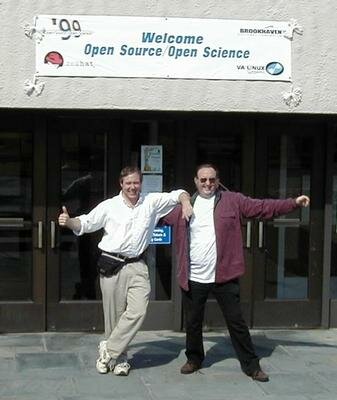 |
So there I strolled along Bell Avenue, heading north towards the bank. A bright breezy day. The surrounding trees vibrated in fall color. Peace and quiet. "So what's next?" was a thought I was trying to avoid. I was recovering from my 4 month marathon organizational project. I was going to have to heal some open wounds I had left with my colleagues over in PHENIX. They were threatening to take my name off the authorship list of the PHENIX experiment for skipping out on all their meetings and generally blowing them off. Finally, I was going to have to think about the future. "Open Source/Open Science 2K. Hmmm that has a nice ring to it."
I would like to thank Matthew Prete, Joe Louderback and Andrew Pimlott for their corrections to the grammar and spelling of this article. Thanks guys.
Copyright © 1999, Stephen Adler
Published in Issue 48 of Linux Gazette, December 1999
![[ Table of Contents ]](../gx/indexnew.gif)
![[ Front Page ]](../gx/homenew.gif)
![[ Prev ]](../gx/back2.gif)
![[ Linux Gazette FAQ ]](./../gx/dennis/faq.gif)
![[ Next ]](../gx/fwd.gif)

![[ Table of Contents ]](../gx/indexnew.gif)
![[ Front Page ]](../gx/homenew.gif)
![[ Linux Gazette FAQ ]](./../gx/dennis/faq.gif)




















